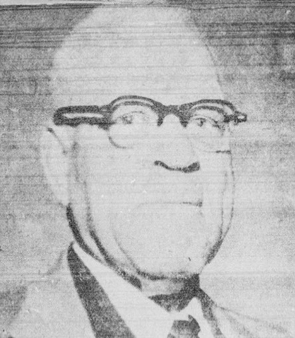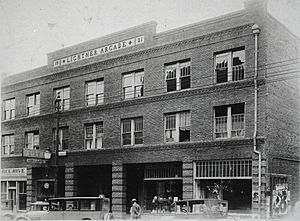Calvin E. Lightner facts for kids
Calvin Esau Lightner (born March 31, 1878 – died May 21, 1960) was an important American architect, builder, and funeral director. He was born in South Carolina. He moved to Raleigh, North Carolina to study architecture at Shaw University. After college, he took more classes at Hampton Institute. He also studied how to prepare bodies for burial in Tennessee. He and his brother started a construction company called C. E. Lightner and Brothers. They built many homes for black families in Raleigh.
Lightner opened the first funeral home for black customers in Raleigh. It was on East Hargett Street. He then built many other businesses along this street. This made East Hargett Street the main place for black-owned businesses in Raleigh. People called it the city's "Black Main Street." In 1919, he and two other black men ran for city jobs. They wanted to get black people more interested in politics. Lightner wanted to be the Commissioner of Public Works. But Jim Crow laws made it hard for most black men to vote. So, all three lost their elections. Lightner still got 142 votes.
In 1921, he built the Mechanics and Farmers Bank Building in Durham. He also built the Lightner Arcade and Hotel in Raleigh. This hotel quickly became a popular social spot for Raleigh's black community. Famous musicians like Cab Calloway, Count Basie, and Duke Ellington performed there. Lightner sold his hotel in 1925. In 1959, he gave his funeral business to his son, Clarence. Calvin Lightner died the next year. His son Clarence became the first black Mayor of Raleigh in 1973. Most of the buildings Lightner built are not standing today.
Early Life and Learning
Calvin Lightner was born on March 31, 1878. His hometown was Winnsboro, South Carolina, in the United States. His parents were Frank and Daphney Lightner. His father, Frank, was born into slavery. After slavery ended, he became a farmer and a carpenter. He built homes in Chester. Calvin's mother, Daphney, was born free. Her father, Joseph Thompson, was a politician in South Carolina after the Civil War. Frank could not read, but Daphney could.
Calvin went to grade school in Winnsboro. Then he moved to Chester. For a short time, he worked with his father as a carpenter's helper. In 1898, he moved to Raleigh, North Carolina. He started studying architectural design at Shaw University. He finished his degree in 1908. He learned even more by taking industrial classes at Hampton Institute. On July 7, 1909, he married Mamie A. Blackmon. She was also a student at Hampton and taught home economics in Raleigh. They had four children: Calvin, Lawrence, Clarence, and Margaret. In 1909, he also finished school to become a funeral director in Nashville, Tennessee.
Building a Career
By 1906, Lightner had started a building company. It was called C. E. Lightner and Brothers. He ran it with his brother Rayford in Raleigh. In 1907, he designed and built his own house in Raleigh. After graduating from Shaw, he worked there for a year. He was an assistant teacher in the university's workshop. His construction company built many homes. These homes were for black middle-class families in the east and southeast parts of Raleigh. He also built at least one home for a white client. People said Lightner drew all his own plans for his projects. His company used wooden supports in its buildings.
After college, Lightner worked for another funeral director. Then he started his own funeral home. It was the first one for black people in Raleigh. He first wanted to open it on Fayetteville Street. But that didn't work out. So he looked for property on East Hargett Street. In 1909, he built the Lightner Building there. In 1911, he officially opened the Lightner Funeral Home. It operated from the first floor of the Lightner Building.
He then oversaw the building of many businesses on East Hargett Street. This caused black-owned businesses to move from Wilmington Street to East Hargett. East Hargett Street became known as the city's "Black Main Street." In the 1910s, Lightner and his brother Ralph ran a car repair shop on the street. In 1912, he asked for a group for black funeral directors in North Carolina. A group of funeral directors met during the Colored North Carolina State Fair. They formed an association and chose Lightner as their president. In the 1920s, he started Hillcrest Cemetery. It was a private cemetery for Raleigh's black residents.
Lightner was a member of the National Association for the Advancement of Colored People (NAACP). In 1919, he and two other black men ran for city jobs in Raleigh. Their goal was to encourage black people to get involved in politics. Lightner wanted to be the Commissioner of Public Works. But Jim Crow laws made it very hard for black men to vote. All three candidates lost their elections. Lightner received 142 votes, which was the most among the black candidates. He later said, "Even if we had won, we knew the whites wouldn't let us administer. But we just wanted to wake our people up politically." This campaign got support from many black people. But it made some white leaders angry. They then told other white people not to support black businesses in Raleigh. In 1922, he joined a new committee. It was called the Negro New Bern Relief Commission. This group helped people in need.
In 1921, Lightner built the Lightner Arcade and Hotel. It was across the street from the Lightner Building. He joked that he built it because his wife said he hosted too many friends at their home. The arcade quickly became a popular social place for Raleigh's black community. It was one of the best hotels for black guests on the East Coast of the United States. It was one of only two hotels in Raleigh that welcomed black customers. Famous musicians like Cab Calloway, Count Basie, and Duke Ellington stayed and performed there. The building also had a restaurant, a drug store, a barbershop, and the offices of The Carolinian newspaper.
Lightner also greatly updated the Davie Street Presbyterian Church in 1922. He became a member of that church. In 1921, he built the Mechanics and Farmers Bank Building in Durham. The next year, he built a Mechanics and Farmers branch building on East Hargett Street in Raleigh. Lightner and his brother sold the hotel in May 1925. They sold it to the Household of Ruth for $108,000. In the 1930s, he created the Wake County Burial League. This group sold insurance to help pay for burials. In 1941, Lightner bought the Capehart House. He moved his funeral home there. He retired the next year. In 1959, he gave control of his funeral home to his son, Clarence.
Later Life and Impact
Calvin Lightner passed away on May 21, 1960. He died at St. Agnes Hospital in Raleigh. His funeral was held on May 25 at Davie Street Presbyterian Church. He was buried in Mt. Hope Cemetery. The Lightner Arcade building burned down in 1970. Lightner's son, Clarence, made history in 1973. He was elected as the first black Mayor of Raleigh. Calvin Lightner's family home was torn down in 1990. By 2020, most of Lightner's buildings were gone. But the Davie Street Presbyterian Church and the Mechanics and Farmers Bank Building in Durham still stand.




